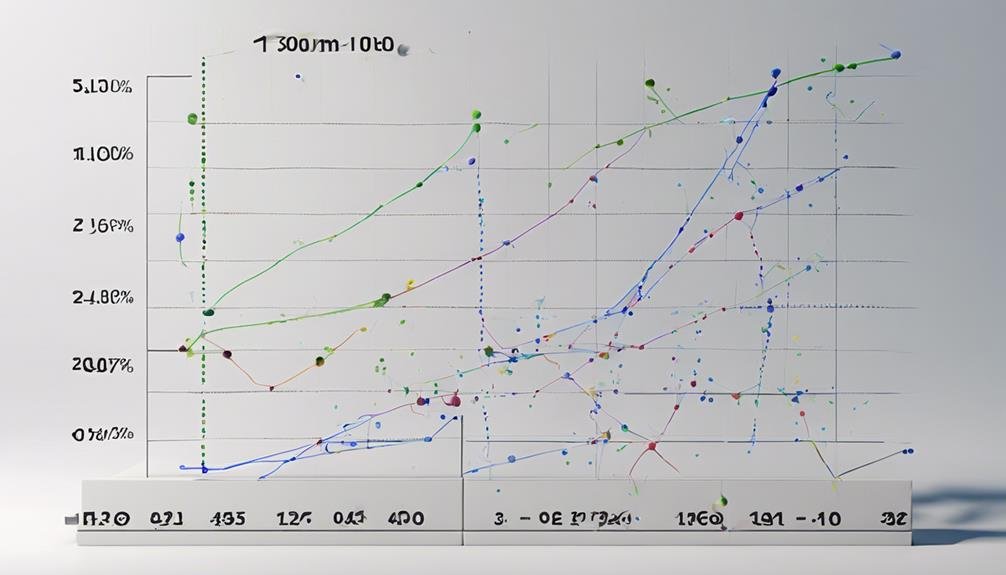The Correlation Coefficient: What It Is and What It Tells Investors
The correlation coefficient is an essential metric for investors, measuring the relationship between assets in a portfolio. By understanding correlations, investors can optimize asset allocation, make informed decisions, and manage risks effectively, leading to better returns. It is vital for evaluating market trends, diversifying investments, and managing risks. Factors like data patterns, significance of relationships, and market conditions influence correlation strength. Interpreting correlation coefficients helps in constructing resilient investment portfolios and enhancing risk-adjusted returns. Utilizing correlation data aids in diversification and risk management strategies. Exploring the correlation coefficient further reveals its significance in predicting asset movements and optimizing investment outcomes.
Key Takeaways
- Quantifies relationships between assets in a portfolio.
- Essential for optimizing asset allocation.
- Helps in making informed decisions for better returns.
- Key tool for managing risks effectively.
- Crucial for assessing market trends and diversifying investments.
Importance of Correlation Coefficient in Investing
The correlation coefficient plays an essential role in investment analysis by providing a quantitative measure of the relationship between different assets or securities held within a portfolio. When considering market trends and asset allocation, understanding the correlation between various investments is pivotal. Market trends can impact the performance of assets differently, and by analyzing the correlation coefficient, investors can make informed decisions regarding asset allocation to optimize returns and manage risks effectively.
Factors Influencing Correlation Strength
Factors impacting correlation strength encompass various market dynamics and asset characteristics that influence the relationships between investments.
Data patterns play a vital role in determining correlation strength, as the consistency and trends within the data can affect the degree of correlation between assets.
Additionally, relationship significance is a key factor in understanding correlation strength, where the magnitude and direction of the relationship between variables impact the correlation coefficient.
Factors such as market conditions, industry trends, and economic indicators can also influence correlation strength by shaping the underlying data patterns and the significance of the relationships.
Hence, considering these elements is essential when interpreting and utilizing correlation coefficients in investment decision-making processes.
Practical Applications in Investment Strategies
Practical applications in investment strategies encompass utilizing correlation coefficients to enhance portfolio diversification and manage risks effectively. When considering investment correlations, the following key points are essential for investors:
- Correlation forecasting: Predicting how asset classes or securities will move in relation to each other.
- Diversification enhancement: Using correlation coefficients to identify assets that move differently to reduce portfolio risk.
- Risk management: Employing correlation analysis to understand how investments may behave under different market conditions.
- Portfolio optimization: Adjusting asset allocations based on correlation coefficients to achieve desired risk-return profiles.
Interpreting Correlation Coefficients in Portfolios
When examining investment strategies, understanding and interpreting correlation coefficients within portfolios is essential for effective risk management and diversification. Portfolio performance hinges on the relationships between various assets, making the correlation coefficient an important tool for investors.
By analyzing the correlation coefficients of assets within a portfolio, investors can gauge how different investments move concerning each other. This insight is instrumental in optimizing asset allocation to enhance diversification and reduce overall portfolio risk. A well-diversified portfolio with assets that have low or negative correlation coefficients can potentially improve overall portfolio performance by mitigating the impact of market fluctuations.
As such, interpreting correlation coefficients plays a key role in constructing resilient and high-performing investment portfolios.
Role of Correlation Analysis in Risk Management
An essential component of effective risk management in investment strategies involves the meticulous analysis of correlation coefficients to evaluate the interplay between asset classes and their impact on portfolio volatility. This analysis plays an important role in risk assessment and portfolio optimization.
Here's why correlation analysis is essential for risk management:
- Identifying Diversification Opportunities: Understanding correlations helps in diversifying investments to reduce risk.
- Quantifying Portfolio Risk: Correlation coefficients quantify the level of risk associated with different assets.
- Enhancing Risk-Adjusted Returns: By analyzing correlations, investors can optimize portfolios for better risk-adjusted returns.
- Mitigating Concentration Risk: Utilizing correlation data helps in managing concentration risk within a portfolio.
Utilizing Correlation Data for Diversification
The utilization of correlation data in diversification strategies plays a pivotal role in enhancing portfolio risk management and optimizing investment outcomes. By analyzing correlation coefficients, investors can identify the degree to which assets move in relation to each other. This information is vital for portfolio optimization and risk mitigation.
Correlations help in constructing a diversified portfolio by including assets that have low or negative correlations, thereby reducing overall portfolio risk. Understanding how different assets behave in relation to one another allows investors to spread risk more effectively.
Future Trends in Correlation Coefficient Usage
In what ways are emerging technologies shaping the future utilization of correlation coefficients in investment analysis?
- Predictive Analytics: Incorporating advanced predictive analytics tools allows investors to forecast future correlations more accurately.
- Market Trends: Adapting correlation coefficient usage to changing market trends enables investors to make more informed decisions in dynamic environments.
- Machine Learning Integration: Integrating machine learning algorithms enhances the accuracy and efficiency of correlation coefficient calculations.
- Real-Time Data Analysis: Leveraging real-time data for correlation coefficient analysis provides investors with up-to-date insights for quicker decision-making processes.
These trends signify a shift towards more sophisticated and data-driven approaches in utilizing correlation coefficients for investment analysis, emphasizing the importance of staying ahead in a fast-paced financial landscape.
Conclusion
To sum up, the correlation coefficient serves as a valuable tool for investors in understanding the relationships between variables. By analyzing the strength and direction of linear associations, investors can make informed decisions in risk assessment and diversification strategies.
The significance of correlation coefficients extends beyond numerical values, offering insights into portfolio management and quantitative trading strategies. As the saying goes, 'correlation does not imply causation,' highlighting the need for a thorough understanding of statistical measures in investment analysis.







